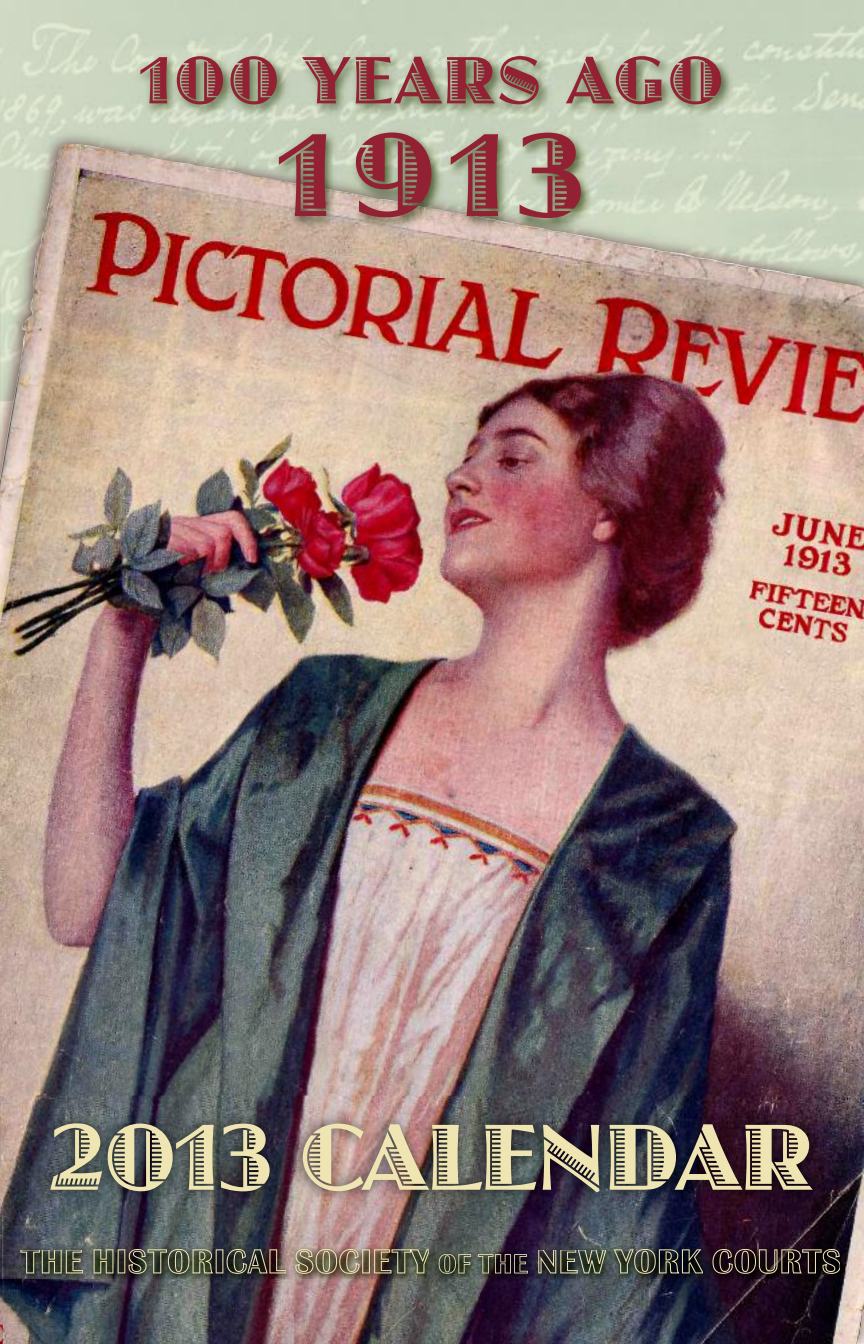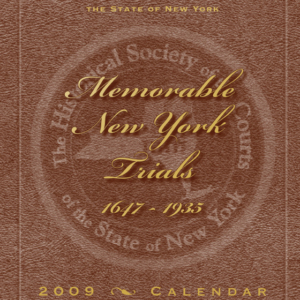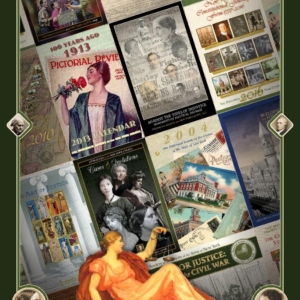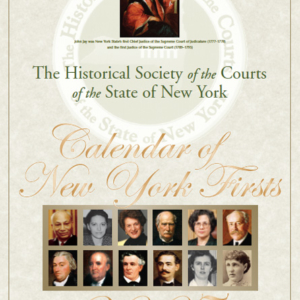Description
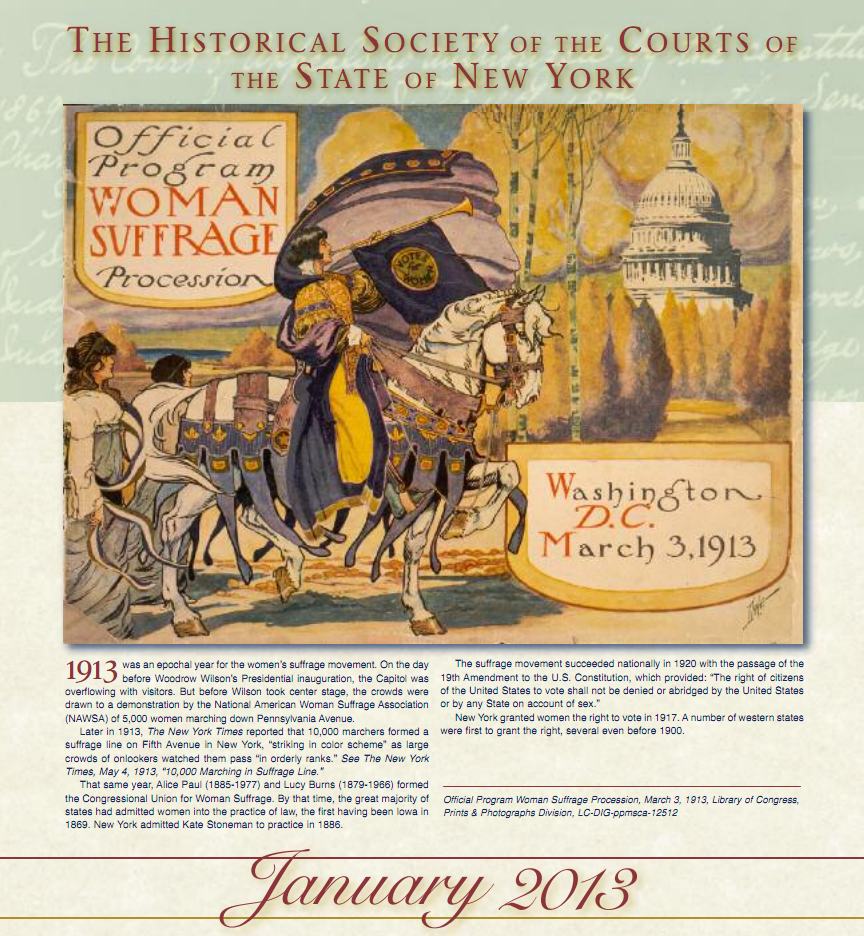
1913 was an epochal year for the women’s suffrage movement. On the day before Woodrow Wilson’s Presidential inauguration, the Capitol was overflowing with visitors. But before Wilson took center stage, the crowds were drawn to a demonstration by the National American Woman Suffrage Association (NAWSA ) of 5,000 women marching down Pennsylvania Avenue.
Later in 1913, The New York Times reported that 10,000 marchers formed a suffrage line on Fifth Avenue in New York, “striking in color scheme” as large crowds of onlookers watched them pass “in orderly ranks.” See The New York Times, May 4, 1913, “10,000 Marching in Suffrage Line.”
That same year, Alice Paul (1885-1977) and Lucy Burns (1879-1966) formed the Congressional Union for Woman Suffrage. By that time, the great majority of states had admitted women into the practice of law, the first having been Iowa in 1869. New York admitted Kate Stoneman to practice in 1886.
The suffrage movement succeeded nationally in 1920 with the passage of the 19th Amendment to the U.S. Constitution, which provided: “The right of citizens of the United States to vote shall not be denied or abridged by the United States or by any State on account of sex.”
New York granted women the right to vote in 1917. A number of western states were first to grant the right, several even before 1900.
Image:
Official Program Woman Suffrage Procession, Washington, D.C. March 3, 1913, Library of Congress, Prints & Photographs Division, LC-DIG-ppmsca-12512
February 2013

The smoking- jacketed gentleman is reading an unidentified book. If he was seeking to be up to the moment in the law, he would be perusing 208, 209, or 210 N.Y., the volumes that spanned the year 1913. Like today, news from the courts would occasionally be of interest to the press.
One of the few times the New York Court of Appeals appeared prominently in the news – and perhaps the lengthiest and most colorful treatment that year – was in a December 14, 1913 article in The New York Times carrying the headline: “Blames the Judges for the Billboards.”
The article reported on a talk by Raymond B. Fosdick, a prominent New York figure, at the City Club, castigating the Court for allowing “hideous sky signs on three sides” of the New York Public Library, Fifth Avenue and 42nd Street. The article did not mention the case, but it would have been People ex rel. M. Wineburgh Advertising Co. v. Murphy, 195 N.Y. 126 (1909), in which a unanimous court upheld the right to display “sky signs” on the roofs of buildings for the display of advertising so long as they don’t impact public health, morals or safety:
“An ordinance which purports to legislate for public safety must tend in some appreciable way to that end. Unless there is a substantial connection between the assumed purpose of the ordinance and the end to be accomplished, such ordinance is unenforceable.”
Mr. Fosdick would not be thrilled by Times Square.
Images:
J.C. Leyendecker, “Men Reading,” Arrow Collar Advertisement, 1912, location unknown
J.C. Leyendecker, Arrow Collar Advertisement, 1916, location unknown
March 2013

The 1913 Red Book lists all of the County District Attorneys for that year. Several went on to further prominence, including:
- John C. Crapser of St. Lawrence County, served as a Justice of the Appellate Division
- Edward A. Conger of Dutchess County, appointed by President Franklin D. Roosevelt to the United States District Court for the Southern District of New York
- Charles S. Whitman of New York County, served as New York’s 41st Governor from 1915-1918
- Rollin B. Sanford of Albany, served as a member of the United States Congress from 1915-1921
- George H. Bond of Onondaga County, served as President of the New York State Bar Association in 1938
There were no women on the 1913 list, but one merits high mention. Eunice Hunton Carter was 14 years old that year. Men continued to dominate this office up through the 1930’s, and it was into that world that Eunice Hunton Carter began to make her mark. She was a pioneer as an African – American woman, the first female assistant district attorney in New York, serving on District Attorney Thomas Dewey’s staff in 1936. Notably, she assisted in the prosecution of Charles “Lucky” Luciano. Her grandson is Stephen L. Carter, Yale law School professor and novelist.
The office of District Attorney in New York had its statutory origins with the creation of “districts” for assistant attorneys general (L. 1796, ch 8). In 1801, the legislature created the office of “District Attorney” to correspond to certain enumerated districts comprised of several counties. The district system continued until 1818 when the Legislature provided for the appointment of a District Attorney for each county (.L 1818, ch 283). With the Constitution of 1846, District Attorneys were elected by County.
Images:
Murlin, Edgar L. The New York Red Book, at 700 (J.B. Lyon Company, Albany, 1913)
Eunice Hunton Carter, 1935
April 2013
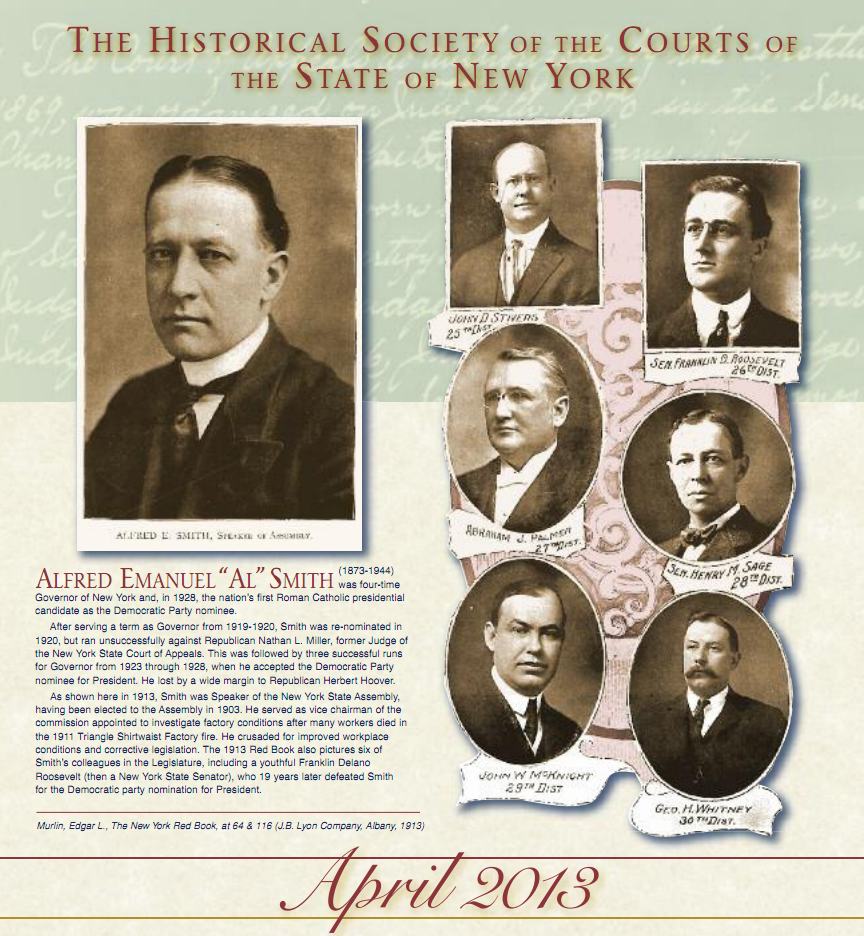
Alfred Emanuel “Al” Smith (1873-1944) was four-time Governor of New York and, in 1928, the nation’s first Roman Catholic presidential candidate as the Democratic Party nominee.
After serving a term as Governor from 1919-1920, Smith was re-nominated in 1920, but ran unsuccessfully against Republican Nathan L. Miller, former Judge of the New York Court of Appeals. This was followed by three successful runs for Governor from 1923 through 1928, when he accepted the Democratic Party nominee for President. He lost by a wide margin to Republican Herbert Hoover.
As shown here in 1913, Smith was Speaker of the New York State Assembly, having been elected to the Assembly in 1903. He served as vice chairman of the commission appointed to investigate factory conditions after many workers died in the 1911 Triangle Shirtwaist Factory fire. He crusaded for improved workplace conditions and corrective legislation. The 1913 Red Book also pictures six of Smith’s colleagues in the Legislature, including a youthful Franklin Delano Roosevelt (then a New York State Senator), who 19 years later defeated Smith for the Democratic party nomination for President.
Images:
Murlin, Edgar L. The New York Red Book, at 64 & 116 (J.B. Lyon Company, Albany, 1913)
May 2013
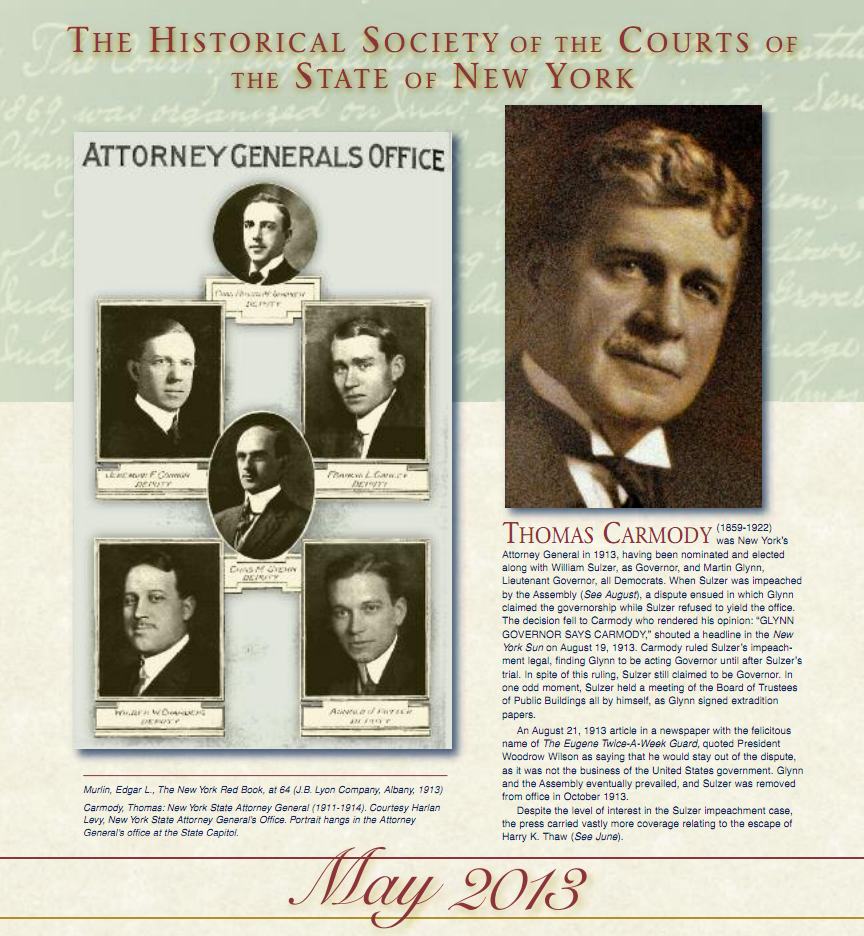
Thomas Carmody (1859-1922) was New York’s Attorney General in 1913, having been nominated and elected along with William Sulzer, as Governor, and Martin Glynn, Lieutenant Governor, all Democrats. When Sulzer was impeached by the Assembly (See August), a dispute ensued in which Glynn claimed the governorship while Sulzer refused to yield the office. The decision fell to Carmody who rendered his opinion: “GLYNN GOVERNOR SAYS CARMODY,” shouted a headline in the New York Sun on August 19, 1913. Carmody ruled Sulzer’s impeachment legal, finding Glynn to be acting Governor until after Sulzer’s trial. Defying this ruling, both Sulzer and Glynn professed to be Governor. In one odd moment, Sulzer held a meeting of the Board of Trustees of Public Buildings all by himself, as Glynn signed extradition papers.
An August 21, 1913 article in a newspaper with the felicitous name of The Eugene Twice-A-Week Guard, quoted President Woodrow Wilson as saying that he would stay out of the dispute, as it was not the business of the United States government. Glynn and the Assembly eventually prevailed, and Sulzer was removed from office in October 1913.
Despite the level of interest in the Sulzer impeachment case, the press carried vastly more coverage relating to the escape of Harry K. Thaw (See June).
Images:
Murlin, Edgar L. The New York Red Book, at 64 (J.B. Lyon Company, Albany, 1913)
Carmody, Thomas: New York State Attorney General (1911-1914). Courtesy New York State Attorney General’s Office. Portrait hangs in the Attorney General’s office at the State Capitol.
June 2013
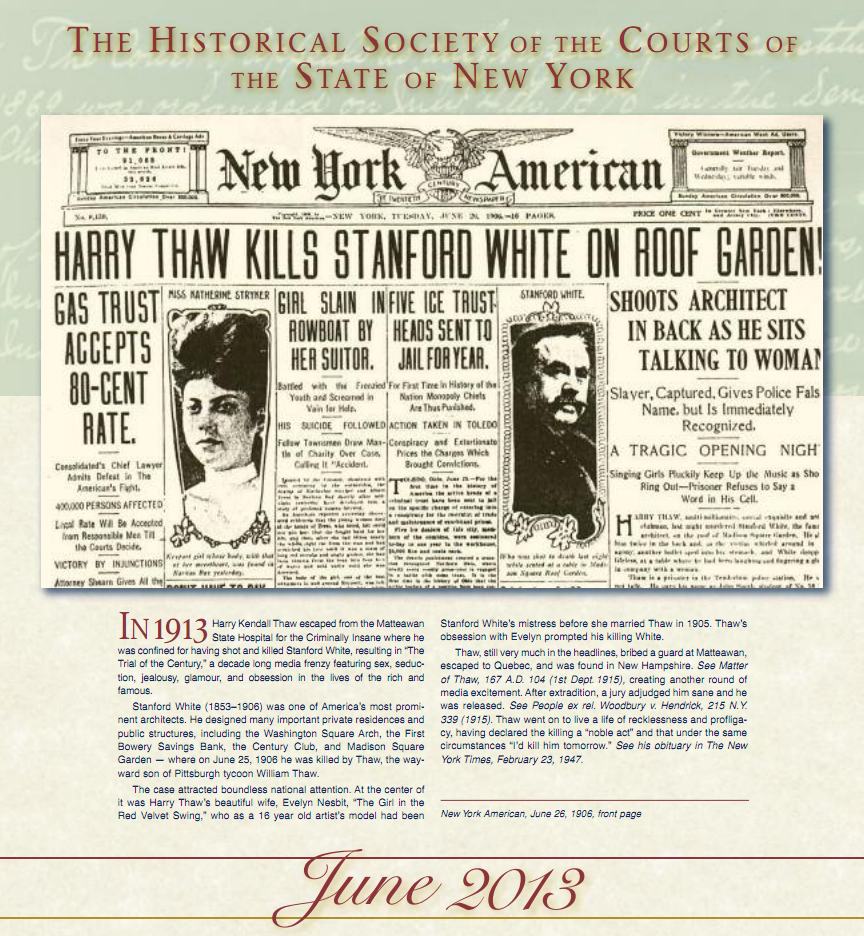
In 1913 Harry Kendall Thaw escaped from the Matteawan State Hospital for the Criminally Insane where he was confined for having shot and killed Stanford White, resulting in “The Trial of the Century,” a decade long media frenzy featuring sex, seduction, jealousy, glamour, and obsession in the lives of the rich and famous.
Stanford White (1853–1906) was one of America’s most prominent architects. He designed many important private residences and public structures, including the Washington Square Arch, the First Bowery Savings Bank, the Century Club, and Madison Square Garden – where on June 25, 1906 he was killed by Thaw, the wayward son of Pittsburgh tycoon William Thaw.
The case attracted boundless national attention. At the center of it was Harry Thaw’s beautiful wife, Evelyn Nesbit, “The Girl in the Red Velvet Swing,” who as a 16 year old artist’s model had been Stanford White’s mistress before she married Thaw in 1905. Thaw’s obsession with Evelyn prompted his killing White.
Thaw, still very much in the headlines, bribed a guard at Matteawan, escaped to Quebec, and was found in New Hampshire. See Matter of Thaw, 167 A.D. 104 (1st Dept. 1915), creating another round of media excitement. After extradition, a jury adjudged him sane and he was released. See People ex rel. Woodbury v. Hendrick, 215 N.Y. 339 (1915). Thaw went on to live a life of recklessness and profligacy, having declared the killing a “noble act” and that under the same circumstances “I’d kill him tomorrow.” See his obituary in The New York Times, February 23, 1947.
Images:
New York American, June 26, 1906, front page
July 2013
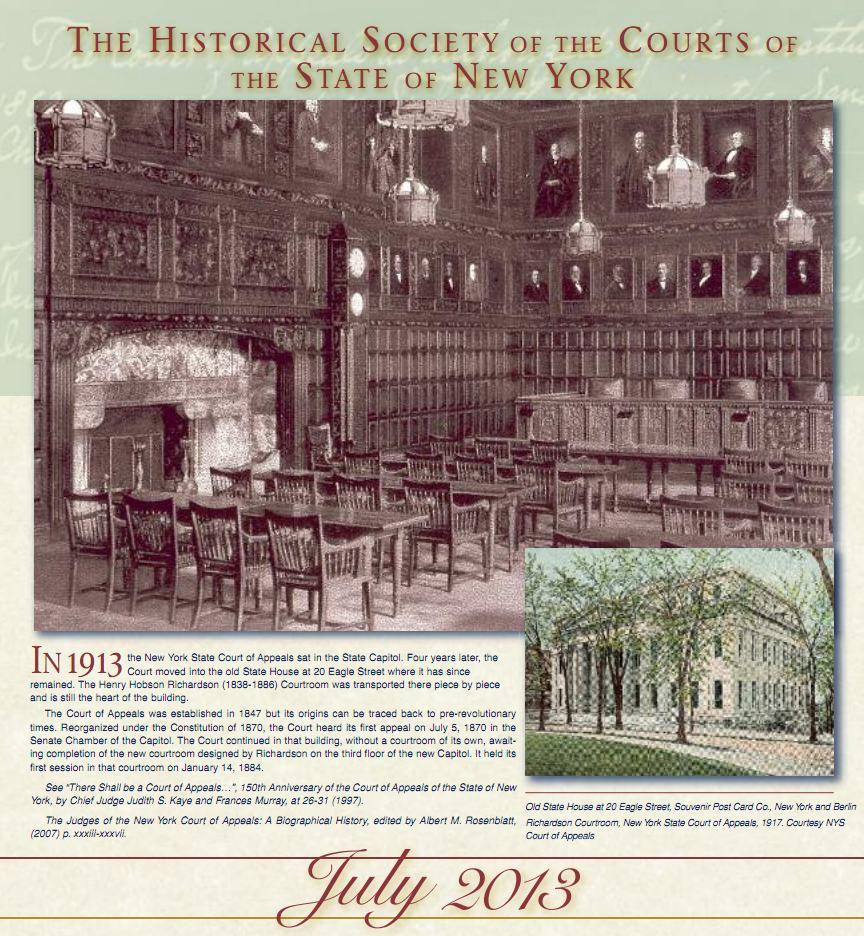
In 1913 the Court of Appeals sat in the State Capitol. Four years later, the Court moved into the old State House at 20 Eagle Street where it has since remained. The Henry Hobson Richardson (1838-1886). Courtroom was transported there piece by piece and is still the heart of the building.
The Court of Appeals was established in 1847 but its origins can be traced back to pre-revolutionary times. Reorganized under the Constitution of 1870, the Court heard its first appeal on July 5, 1870 in the Senate Chamber of the Capitol. The Court continued in that building, without a courtroom of its own, awaiting completion of the new courtroom designed by Richardson on the third floor of the new Capitol. It held its first session in that courtroom on January 14, 1884.
See “There Shall be a Court of Appeal…”, 150th Anniversary of the Court of Appeals of the State of New York by Chief Judge Judith S. Kaye and Frances Murray, at 26-31 (1997)
Albert M. Rosenblatt, The Judges of the New York Court of Appeals,(2007) p. xxxiii-xxxvii.
Images:
Old State House at 20 Eagle Street, Souvenir Post Card Co., New York and Berlin
Richardson Courtroom, New York State Court of Appeals, 1917. Courtesy New York State Court of Appeals
August 2013

On August 13, 1913, the New York State Assembly voted to impeach Governor William Sulzer by a vote of 79 to 45. He was the only New York Governor ever to be impeached. See the article by John Dunne “The Impeachment of Governor William Sulzer,” in the Society’s periodical Judicial Notice, Issue 6, January 2009. It can be found on our website.
Sulzer’s trial before the Impeachment Court began in Albany on September 18th of that year, with the eminent Louis Marshall (1856-1929) heading his defense team. Dismissive of the charges as fraudulent and politically motivated, Sulzer refused to testify in his own defense. The Court found him guilty of filing a false report with the Secretary of State concerning his campaign contributions, committing perjury, and advising another person to commit perjury before an Assembly committee. On October 17th, Sulzer was removed from office and succeeded by Lt. Gov. Martin H. Glynn. See People ex rel. Sulzer v. Sohmer, 211 N.Y. 565 (1914); See also, “Lawyers Fight Sulzer Case on Money Charges,” The New York Times, Oct. 10, 1913, front page.
A month after his removal, Sulzer wrote an article in the November 27, 1913 issue of Leslie’s Illustrated Weekly Newspaper (shown here) entitled “What’s the Matter with Tammany.”
Sulzer recovered politically to some extent and won election as an independent to the New York State Assembly on November 4, 1913. Sulzer then ran as the Prohibition and American Parties’ candidate for Governor in 1914. In 1916 he declined the American Party nomination for President of the United States.
Images:
Murlin, Edgar L. The New York Red Book, frontispiece (J.B. Lyon Company, Albany, 1913)
Leslie’s Illustrated Weekly Newspaper, November 27, 1913, cover “What’s the Matter with Tammany?”
September 2013

Is there anything more idyllic than the 1913 Pierce Arrow or the Packard of the same year? The advertisements evoke sheer elegance for the town and the city.
At the beginning of the 20th century, the automobile did not yet dominate traffic accident cases. Most involved street car and trolley mishaps. The first mention of an automobile in a reported New York decision was in Bittner v. Crosstown S. R. Co., 153 N.Y. 76 (1897), in which the Court referred to a car and motorman, but in the headnote the sophisticated reporter called it an automobile.
The first use of the word automobile by a New York court was in Mason v. West, 61 A.D. 40 (4TH Dept. 1901), in which Judge Alfred Spring, writing for the Appellate Division Fourth Department, revealed that in the City of Rochester, the defendant, “…owned an automobile of somewhat crude and unusual construction and propelled by steam generated by a gasoline burner.”
He continued:
The testimony of the plaintiffs tended to show that the carriage gave forth a loud puffing noise and could be heard for two blocks; that the odor was pronounced; that as the carriage ran along there was a humming sound from its engine; that steam or smoke issued from the exhaust, and that teams had been frightened by it; that at the time of this accident it was passing the plaintiffs’ horse at the speed of ten or twelve miles an hour, and did not slacken until the horse became frightened.
It was not long before automobile cases became pervasive. A computer search reveals that by the end of 1913 the word automobile appears in 416 cases.
Images:
J.C. Leyendecker, Pierce Arrow advertisement, 1913, location unknown
Louis Fancher, Packard “38” Imperial Coupé advertisement, 1913, location unknown
October 2013
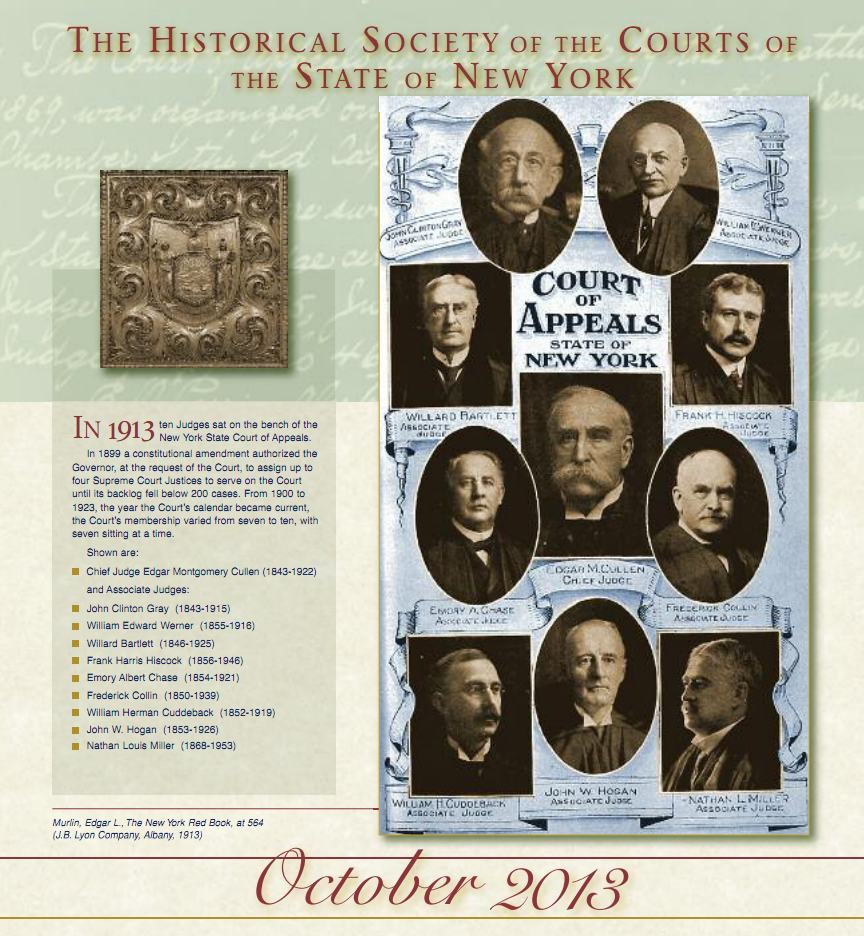
In 1913 ten Judges sat on the bench of the New York Court of Appeals.
In 1899 a constitutional amendment authorized the Governor, at the request of the Court, to assign up to four Supreme Court Justices to serve on the Court until its backlog fell below 200 cases. From 1900 to 1923, the year the Court’s calendar became current, the Court’s membership varied from seven to ten, with seven sitting at a time.
Shown are:
- Chief Judge Edgar Montgomery Cullen (1843-1922)
and Associate Judges:
- John Clinton Gray (1843-1915)
- William Edward Werner (1855-1916)
- Willard Bartlett (1846-1925)
- Frank Harris Hiscock (1856-1946)
- Emory Albert Chase (1854-1921)
- Frederick Collin (1850-1939)
- William Herman Cuddeback (1852-1919)
- John W. Hogan (1853-1926)
- Nathan Louis Miller (1868-1953)
Images:
Murlin, Edgar L. The New York Red Book, at 564 (J.B. Lyon Company, Albany, 1913)
November 2013
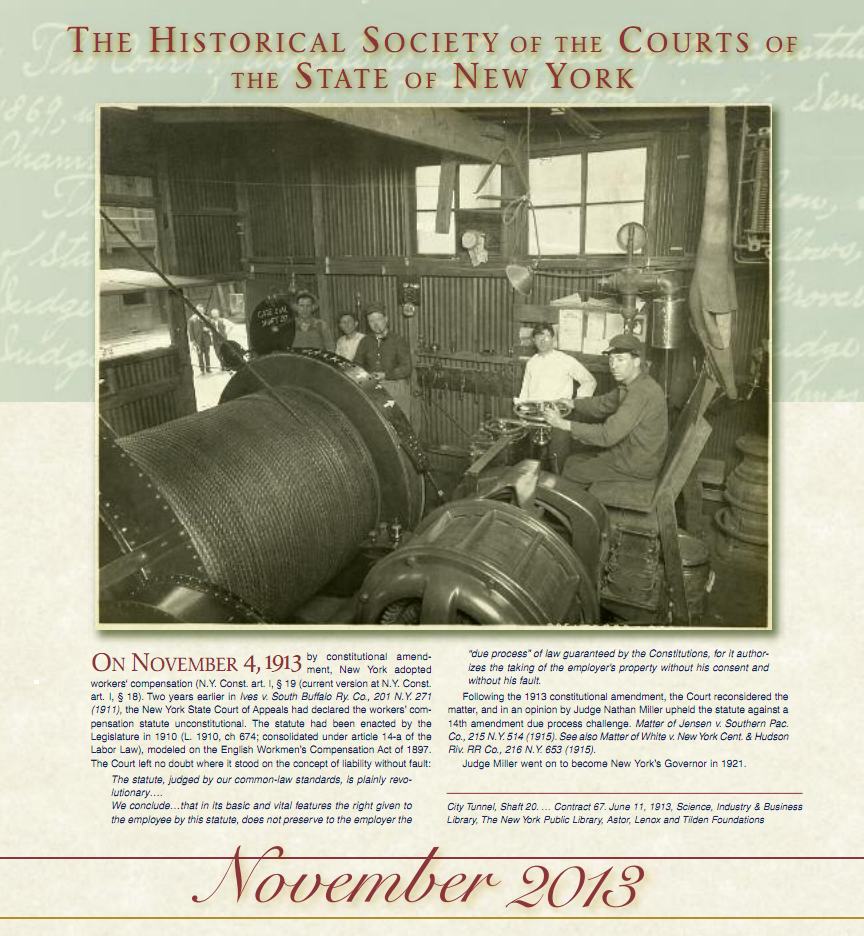
On November 4, 1913, by constitutional amendment, New York adopted workers compensation (N.Y. Const. art. I, § 19 (current version at N.Y. Const. art. I, § 18). Two years earlier in Ives v. South Buffalo Ry. Co., 201 N.Y. 271 (1911), the Court of Appeals had declared the workers compensation statute unconstitutional. The statute had been enacted by the legislature in 1910 (L 1910, ch 674; consolidated under article 14-a of the Labor Law), modeled on the English Workmen’s Compensation Act of 1897. The Court left no doubt where it stood on the concept of liability without fault:
The statute, judged by our common-law standards, is plainly revolutionary….
We conclude…that in its basic and vital features the right given to the employee by this statute, does not preserve to the employer the “due process” of law guaranteed by the Constitutions, for it authorizes the taking of the employer’s property without his consent and without his fault
Following the 1913 constitutional amendment, the Court reconsidered the matter and in an opinion by Judge Nathan Miller upheld the statute against a 14th amendment due process challenge. Matter of Jensen v. Southern Pac. Co., 215 N.Y. 514 (1915). See also Matter of White v. New York Cent. & Hudson Riv. RR Co., 216 N.Y. 653 (1915).
Images:
The New York Herald, March 26, 1911, front page
City Tunnel, Shaft 20. … Contract 67. June 11, 1913, Science, Industry & Business Library, The New York Public Library, Astor, Lenox and Tilden Foundations
December 2013
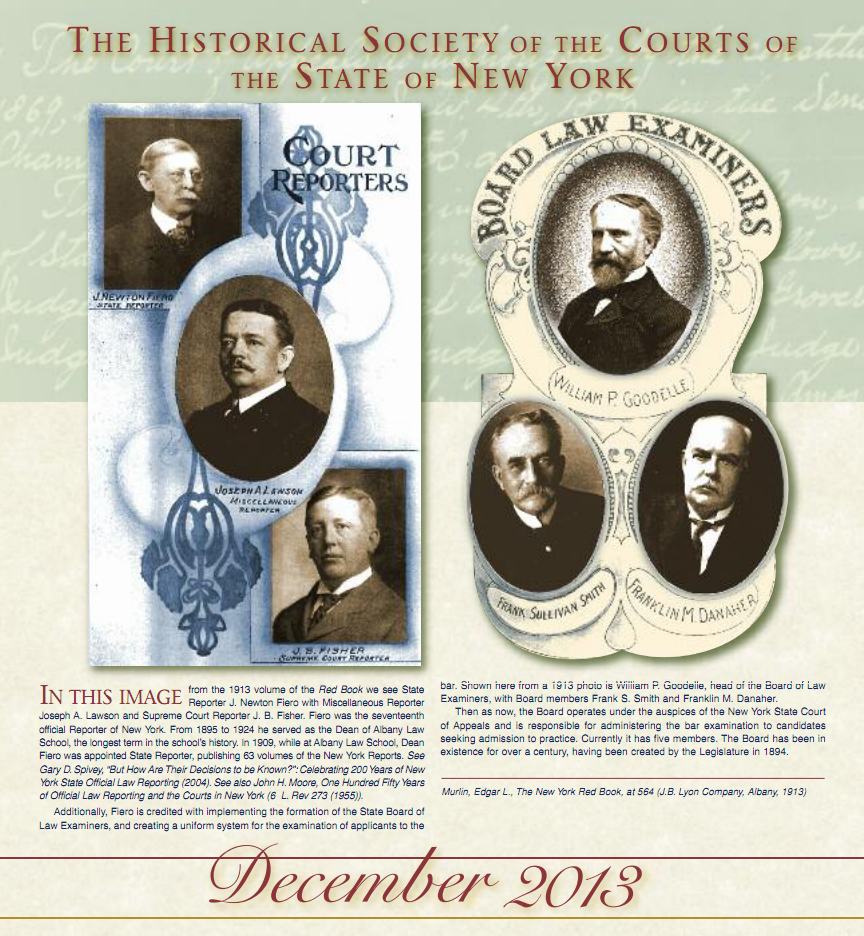
In this image from the 1913 volume of the Red Book we see State Reporter J. Newton Fiero with Miscellaneous Reporter Joseph A. Lawson and Supreme Court Reporter J. B. Fisher. Fiero was the seventeenth official Reporter of New York. From 1895 to 1924 he served as the Dean of Albany Law School, the longest term in the school’s history. In 1909, while at Albany Law School, Dean Fiero was appointed State Reporter, publishing 63 volumes of the New York Reports. See Gary D. Spivey, “But How Are Their Decisions to be Known ?”: Celebrating 200 Years of New York State Official Law Reporting (2004). See also John H. Moore, One Hundred Fifty Years of Official Law Reporting and the Courts in New York (6 Syracuse L. Rev 273 (1955)).
Additionally, Fiero is credited with implementing the formation of the State Board of Law Examiners, and creating a uniform system for the examination of applicants to the bar. Shown here from a 1913 photo is William P. Goodelle, head of the Board of Law Examiners, with Board members Frank S. Smith and Franklin M. Danaher.
Then as now, the Board operates under the auspices of the New York Court of Appeals and is responsible for administering the bar examination to candidates seeking admission to practice. Currently it has five members. The Board has been in existence for over a century, having been created by the Legislature in 1894.
Images:
Murlin, Edgar L. The New York Red Book, at 564 (J.B. Lyon Company, Albany, 1913)

